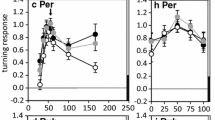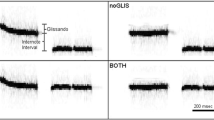Summary
-
1.
The accuracy with whichTeleogryllus oceanicus females orientate to synthetic calling songs, containing carrier frequencies in the range 2.5 kHz to 12 kHz, has been quantified in terms of the angle of incidence of stimulation (target angle) during each pause in the response and the angle through which the female turned immediately following the pause (Figs. 1, 2).
-
2.
Females orientated to the synthetic calls containing carrier frequencies in the range 3.5 kHz to 9 kHz. The highest proportion of turns towards the activated loudspeaker occurred for calls containing 3.5 kHz and 4.5 kHz (Table 1). No phonotactic response occurred to calls containing carrier frequencies of 2.5 kHz and 12 kHz.
-
3.
For calls containing carrier frequencies in the range 3.5 kHz to 9 kHz females made a significant proportion of turns towards the activated loudspeaker for target angles ahead of and behind the lateral axis (Table 2), indicating that females can discriminate between the ipsilateral and contralateral sides for a wide range of target angles.
-
4.
Females became less accurate at discriminating between the ipsilateral and contralateral sides as the frequency in the call was shifted away from 4.5 kHz. For the call containing 4.5 kHz females made a significant proportion of turns towards the activated loudspeaker for target angles greater than 12°–14° to the midline while for calls containing 5.5 kHz, 6.5 kHz and 9 kHz the minimum target angle for which significant side discrimination occurred was greater than 28° to the midline.
-
5.
As the frequency in the call was moved away from 4.5 kHz the probability of a female turning towards the target, for target angles between 0° and 100°, decreased (Fig. 3).
-
6.
When presented the call containing 4.5 kHz females did not scale their turns to target angles between 13° and 93°, but made an average turn of 41°±24° (Fig. 4, Table 2). To target angles greater than 90° to the body axis females made a significantly larger average turn (79°±43°) than to target angles less than 90° (Table 2). Females can, therefore, discriminate between stimulation from an anterior and posterior direction. The magnitude of the difference in the average turn angle to target angles ahead of and behind the lateral axis would suggest a separately programmed motor response for these two categories of target angle.
-
7.
Individual females display a preference for turning left or right of the midline when presented a nondirectional stimulus (Table 3). The neurophysiological and behavioural bias cited in other studies is, therefore, expressed in the phonotactic response.
Similar content being viewed by others
References
Bailey, W.J., Thomson, P.: Acoustic orientation in the cricketTeleogryllus oceanicus (Le Guillou). J. Exp. Biol.67, 61–75 (1977)
Boyan, G.S.: Directional responses to sound in the central nervous system of the cricketTeleogryllus commodus (Orthoptera, Gryllidae). I. Ascending interneurons. J. Comp. Physiol.130, 137–150 (1979)
Elsner, N., Popov, A.V.: Neuroethology of acoustic communication. Adv. Insect Physiol.13, 229–335 (1978)
Hill, K.G.: Carrier frequency as a factor in phonotactic behaviour of female crickets (Teleogryllus commodus). J. Comp. Physiol.93, 7–18 (1974)
Hill, K.G., Boyan, G.S.: Sensitivity to frequency and direction of sound in the auditory system of crickets (Gryllidae). J. Comp. Physiol.121, 79–97 (1977)
Hoy, R.R., Paul, R.C.: Genetic control of song specificity in crickets. Science180, 82–83 (1973)
Larsen, O.N., Michelsen, A.: Biophysics of the ensiferan ear. III. The cricket ear as a four-input system. J. Comp. Physiol.123, 217–227 (1978)
Moiseff, A., Pollack, G.S., Hoy, R.R.: Steering responses of flying crickets to sound and ultrasound: mate attraction and predator avoidance. Proc. Natl. Acad. Sci. USA75, 4052–4056 (1978)
Murphey, R.K., Zaretsky, M.D.: Orientation to calling song by female crickets,Scapsipedus marginatus (Gryllidae). J. Exp. Biol.56, 335–352 (1972)
Nocke, H.: Physiological aspects of sound communication in crickets (Gryllus campestris L.). J. Comp. Physiol.80, 141–162 (1972)
Popov, A.V., Shuvalov, V.F.: Phonotactic behavior of crickets. J. Comp. Physiol.119, 111–126 (1977)
Rheinlaender, J., Kalmring, K., Popov, A.V., Rehbein, H.G.: Brain projections and information processing of biologically significant sounds by two large ventral-cord neurons ofGryllus bimaculatus de Geer (Orthoptera, Gryllidae). J. Comp. Physiol.110, 251–269 (1976)
Wendler, G., Dambach, M., Schmitz, B., Scharstein, H.: Analysis of the acoustic orientation behaviour in crickets (Gryllus campestris L.). Naturwissenschaften67, 99 (1980)
Zaretsky, M.D.: Specificity of the calling song and short term changes in the phonotactic response by female cricketsScapsipedus marginatus (Gryllidae). J. Comp. Physiol.79, 153–172 (1972)
Author information
Authors and Affiliations
Additional information
I wish to thank Dr. W.J. Bailey for providing equipment and supervision during my M.Sc. studies, from which this paper has been abstracted. I would also like to thank the staff and students of the Zoology Department of the University of Western Australia and, in particular, Professor S.D. Bradshaw, Dr. W.R. Black and Mr. J.D. Sandow for assistance and helpful discussion. Finally, thanks are due to the computing staff of the Research School of Biological Sciences for assistance during the final analysis of the data and to Dr. K.G. Hill for critical discussions during the preparation of the manuscript.
Rights and permissions
About this article
Cite this article
Oldfield, B.P. Accuracy of orientation in female crickets,Teleogryllus oceanicus (Gryllidae): dependence on song spectrum. J. Comp. Physiol. 141, 93–99 (1980). https://doi.org/10.1007/BF00611882
Accepted:
Issue Date:
DOI: https://doi.org/10.1007/BF00611882




